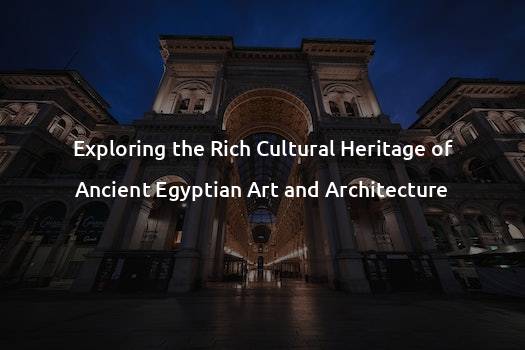Exploring the Rich Cultural Heritage of Ancient Egyptian Art and Architecture
Exploring the Rich Cultural Heritage of Ancient Egyptian Art and Architecture
Ancient Egypt, a civilization that thrived along the banks of the Nile River, left behind a remarkable legacy of art and architecture. Spanning thousands of years, from approximately 3000 BCE to 30 BCE, the art and architecture of ancient Egypt were not only visually stunning but also deeply symbolic and reflective of the rich cultural heritage of the Egyptian people. Let’s delve into the intriguing world of ancient Egyptian art and architecture and uncover the secrets and significance they hold.
Ancient Egyptian Art
Ancient Egyptian art is renowned for its distinctive style and timeless beauty. It primarily served religious and spiritual purposes, emphasizing the importance of the afterlife and the divine. This art form is characterized by the use of symbolism and a focus on achieving permanence in life beyond death.
One of the most recognizable aspects of ancient Egyptian art is the traditional canon of proportions used in representing human figures. Artists depicted men and women with rigid frontalism – the head, torso, and legs were shown in profile, while the eye and shoulders appeared in frontal view. This approach aimed to capture the essential features of the subject, resulting in highly stylized yet powerful representations.
Ancient Egyptian art often featured intricate hieroglyphic writing, which was used to convey complex messages and narratives. These hieroglyphs were developed into an elaborate system of symbols and could be found on monuments, tombs, and even everyday objects.
The themes depicted in ancient Egyptian art were diverse, ranging from religious ceremonies and daily life scenes to depictions of gods, pharaohs, and mythical creatures. These images were primarily intended to convey religious beliefs, offer protection, ensure harmony, and guide the deceased through the afterlife.
Ancient Egyptian Architecture
Ancient Egyptian architecture was grandiose and awe-inspiring, reflecting the power and importance of the pharaohs and their connection to the gods. Temples, palaces, and tombs were built to honor the gods and ensure the continuity of life in the eternal realm.
One of the most iconic examples of ancient Egyptian architecture is the Great Pyramid of Giza, built during the 26th century BCE. This immense structure, constructed as a burial monument for Pharaoh Khufu, is the largest of the three pyramids located on the Giza Plateau near modern-day Cairo. Its impressive symmetry and engineering marvels continue to captivate visitors today, evoking a sense of awe and wonder.
Ancient Egyptian temples were another marvel of architecture. The Temple of Karnak, dedicated to the god Amun-Ra, exemplifies the grandeur and scale of these sacred structures. With its majestic columns, colossal statues, and intricate hieroglyphs, this temple complex served as a center of religious worship and pilgrimage for thousands of years.
A unique feature of ancient Egyptian architecture is the use of hypostyle halls – vast interior spaces supported by rows of columns. These halls, such as the Hypostyle Hall at the Temple of Luxor, created an immersive and sacred atmosphere, inviting worshippers to connect with the divine.
Preservation and Influence
The significance of ancient Egyptian art and architecture extends far beyond the borders of ancient Egypt itself. Their cultural and artistic achievements continue to resonate with people around the world, inspiring countless artists and architects throughout history.
The preservation of ancient Egyptian art and architecture owes much to the dry and arid climate of Egypt. The lack of moisture has protected many structures, statues, and artworks from decay, allowing us to appreciate their splendor today. Additionally, ancient Egyptians’ belief in the afterlife led them to create elaborate burial sites, such as the Valley of the Kings, where treasures and artwork remained untouched for centuries.
Ancient Egyptian motifs and stylistic elements have found their way into various art movements and architectural styles. From the fascination with obelisks in the Renaissance period to the rediscovery of Egyptian themes during the 19th-century Egyptian Revival, ancient Egyptian art continues to captivate and inspire artists and designers worldwide.
TLDR;
Ancient Egyptian art and architecture embody the rich cultural heritage of the Egyptian people. With its distinctive style, symbolism, and focus on the afterlife, ancient Egyptian art captivates viewers to this day. The grandiose architecture, exemplified by the Great Pyramid of Giza and the Temple of Karnak, conveys the power and spirituality of the pharaohs and their connection to the gods. The preservation of these artistic achievements, coupled with their influential characteristics, continues to inspire artists and architects worldwide.







